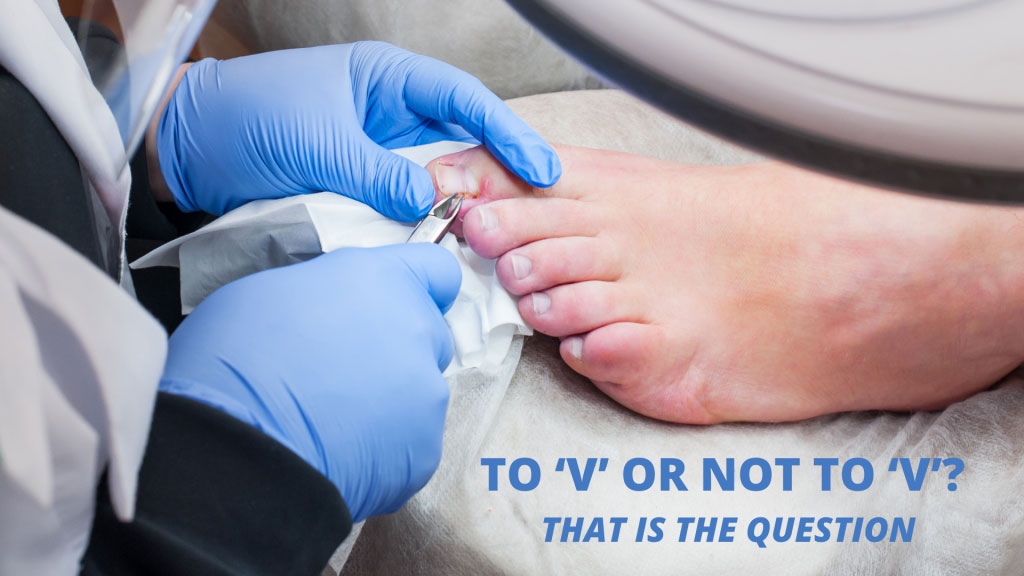Ingrown Nails

To ‘V’ or not to ‘V’? That is the Question!
– written by Andrew Martin, Co-director & Podiatrist
I cannot help but smile, every time one of my patients asks me to cut a ‘V’ in it.
They come into the clinic, having hobbled around for weeks, sometimes even months, before finally deciding to see a Podiatrist.
They explain who or what caused the ingrown nail, then they proceed to tell me exactly how we are going to manage the problem.
Surprisingly often, in among their proposed management plan, is the request to “cut a ‘V’ in it.”
To be fair, not all patients come in with these predetermined management strategies and ideas for ingrown nails. In fact, it is probably a small minority, however, these are the patients and conversations that capture my attention and stick in my head, and give me a good laugh.
There are so many old wives’ tales or home remedies for the management of ingrown nails. Some of these can be helpful, some are a waste of time, and others can be dangerous.
Let’s have a look at what an ingrown nail is, what can cause one, and the effectiveness of a few of the better known ‘home remedies.’
An ingrown nail begins as a soft tissue irritation down the side or sulcus of a nail. Often, the hard edge of the nail causes the skin to break, creating a small wet wound. In other instances, hard skin or callus may build up down the side of the nail, creating a small corn. This usually does not create a wound or skin break, however the pressure can still be very painful.
After this initial irritation, the soft tissue becomes increasingly inflamed or swollen, resulting in greater pressure on the edge of the nail. Perhaps rather than calling this condition an ‘ingrown nail’, we would be more accurate referring to it as ‘swollen toe’. With very few exceptions, an ingrown nail is not when a nail has changed the direction that it grows. It does not simply turn around and start ‘growing in’.
Common causes of ingrown nails include;
- Hereditary involuted (curved) nails
- Poor nail cutting technique
- Ripping or tearing toenails (teenagers)
- Tight or poorly fitting shoes
- Sporting activities that cause mild toe trauma (soccer, football, ballet etc)
- Acute trauma from stubbing or kicking your toe.
The short-term management of an ingrown nail should focus on reducing the ongoing irritation between the nail edge and the inflamed tender surrounding skin.
Remedies and their effectiveness.
- Cut a ‘V’ in it. This has absolutely no benefit. To be able to cut a ‘V’ in your nail, you must first grow your nail unnecessarily long which will increase pressure. Then when you cut a V, it will still have no bearing on nail growth. This will not draw the edges of the nail in.
- Just get antibiotics from your doctor. This can help prevent or resolve any infection that is present. It may also help, reduce the inflammation around the nail edge, however it does not address the issue. It really just buys you some time to sort out the real problem.
- Put betadine or antiseptic cream on it. This can be helpful to keep the site clean, but as above, it does not address the cause of the irritation.
- Pack under the nail with cotton wool. This can be risky. Packing can increase the pressure, therefore increase pain. It can also increase the chance of infection, depending on what is used. This is not something I would recommend.
- Soak it in a warm salt solution. This may offer some minor short-term pain relief, and assist a little in cleaning the site, but again, does not address the cause. If you wish to do this, I would advise a brief salt water rinse, rather than a long soak. This does not mean a barefoot swim at the beach.
- Rip, chop or tear the nail edge out to create more space. I strongly advised against these crude surgeries. They almost always leave a new jiggered nail edge deeper down the nail sulci in a less accessible location. This usually makes the condition worse in the long term.
- Wait for the nail to grow through. Assuming there are no ongoing issues such as tight shoes, this strategy may lead to a resolution, my concern with this is how long will it take? And how uncomfortable it will it be for this period. I think there are much more positive and effective strategies that can be employed.
More effective management options to consider
- Have a critical look at all your shoes, checking they are not too short, too shallow, or too pointy. Avoiding pressure on the toe is the key here. Pain will usually let you know whether the shoes are ok or not……..be honest!
- Gentle roll or massage the tender skin away from the nail edge. Do not poke things in there, cut, rip or tear down the side of the nail to get the ‘sharp bit’ out. The most likely outcome from attempting this is that you will create a small spur that may increase the irritation.
- Talk to a Podiatrist about possible short-term conservative relief, or more permanent surgical correction, especially for recurring issues or very curved nails. You may be advised to see your GP about possible antibiotics if an infection is suspected.
Generally all ingrown nails are manageable and there is really no need to put up with sore toenails for any extended period. If, with a little bit of help, you can identify the cause of your discomfort and are willing to make a change to address this cause, then nail comfort should not be too hard to achieve.
Click here to contact us regarding your nail care.
